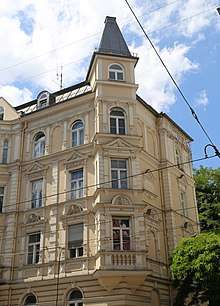Müllerstraße
The Müllerstraße is a 700 meter long street in the Munich Glockenbachviertel.
Junction Müllerstraße and Fraunhoferstraße | |
| Length | 700 m (2,300 ft) |
|---|---|
| Location | Munich |
| Postal code | 80469 |
| Nearest metro station | Sendlinger Tor (U1, U2, U3, U4, U6, U7)[1] |
| Coordinates | 48.130921°N 11.570570°E |

Description
The Müllerstraße is considered the center of the Glockenbachviertel, and therefore a focal point of the Munich gay and lesbian scene, an art and gallery district and party mile. Recently, it is subject to gentrification, such as through The Seven (with a price per square meter of up to 22,000 euros) in the Müllerstraße 7 or numerous hipster shops.[2]
The gay and lesbian communication and cultural center (SUB) has its counseling center at Müllerstraße 43. At number 11,[3] there is a commemorative plaque for the poet Franz Stelzhamer.[4] On the third floor of the building is the office of Little Teddy Recordings: Liam Lynch, Pete and the Pirates and Stereo Total have already released records under this label. In the street there are numerous clubs and bars, such as the Pimpernel, M. C. Müller, or the Ochsengarten, which opened in 1967 and is the first Leather-Bar in Germany, to which admission is reserved for men only. Freddie Mercury is known to have been seen there.[5] Former clubs in the Müllerstraße were the gay club construction (with darkroom) and the bank. In the Müllerstraße 2-6 is the migration and cultural center Bellevue di Monaco, which opened in 2018.[6] In Müllerstraße 14 is the Gay Outdoor Club Munich.
On Müllerstraße are the tram lines 16 and 18, and N27.
Müllerstraße is the location of the cultural history trail: Ludwigsvorstadt-Isarvorstadt.
History
Müllerstraße is named after the numerous mills that were located on the, not yet dried, streams in front of the city in the 19th century. There was also the "women's outdoor pool in the bathhouse in the Müllerstraße" located on the stream.[7]
Müllerstraße 40 is the location of the former "Optical Institute" by Joseph von Utzschneider, later in March, a palatial, classical building, richly structured and decorated,[8] built in 1829 by Joseph Höchl;[9] on the facade of the house is a statue of the Virgin Mary and a bust representing Fraunhofer and Utzschneider, which was created by Halbig and is inscribed with the year 1866.
At the Müllerstraße 7, at the location of "The Seven" the tower of an unused power plant was converted to Munich's most expensive apartments, on the grounds of which first stood the Bavarian military hospital[10] and then until the destruction by bombs in 1944 the Luitpold-Gymnasium.[11] Albert Einstein went to school there from 1888 to 1894.[12] In the time of the Münchner Räterepublik (Munich Soviet Republic) in April 1919, the high school was the scene of violence, as the Red Army killed ten supporters of the folk Thule Society. The Free Corps retaliated in early May 1919 with merciless terror and multiple murders.[13] In 1940/41, the Müllerstraße Hochbunker was built there, followed by the Müllerstraße heating plant in 1954-1956.[11]
 "Women's outdoor pool in the bathhouse in the Müllerstraße", 1880
"Women's outdoor pool in the bathhouse in the Müllerstraße", 1880 Luitpold-Gymnasium, postcard from 1848
Luitpold-Gymnasium, postcard from 1848- The seven
References
| Wikimedia Commons has media related to Müllerstraße (Munich). |
- "München, Sendlinger Tor" (in German). Münchner Verkehrs- und Tarifverbund. Retrieved 26 October 2018.
- "Partymeile mit Hang zum Luxus" (in German). Süddeutsche Zeitung. 12 September 2011. Retrieved 26 October 2018.
- "Mietshaus mit Walmdach" (in German). Stadtportal München. Retrieved 26 October 2018.
- "Stelzhammer" (in German). Stadtgeschichte München. Retrieved 26 October 2018.
- "Spurensuche: So lebte Freddie Mercury in München" (in German). tz München. 9 November 2016. Retrieved 26 October 2018.
- "Ein Ort zum Vorzeigen" (in German). Süddeutsche Zeitung. 6 June 2018. Retrieved 26 October 2018.
- "Eröffnung Müller'sches Volksbad" (in German). Stadtwerke München. Retrieved 26 October 2018.
- Tassilo Selmayr (10 February 2014). "Eine Spurensuche in Freising und Umgebung" (in German). Fink. Retrieved 26 October 2018.
- "Ehem. Optisches Institut" (in German). Stadtportal München. Retrieved 26 October 2018.
- "Geschichte des Gärtnerviertels" (in German). Retrieved 26 October 2018.
- Anita Kuisle. "1887–1944 Schulen in der Müllerstraße" (in German). Franz Schiermeier Verlag. Retrieved 26 October 2018.
- "Albert Einsteins Abiturzeugnis". einstein-website.de (in German). Retrieved 26 October 2018.
- "Kultur Geschichtspfad Ludwigsvorstadt Isavorstadt" (in German). Landeshauptstadt München. Retrieved 26 October 2018.
